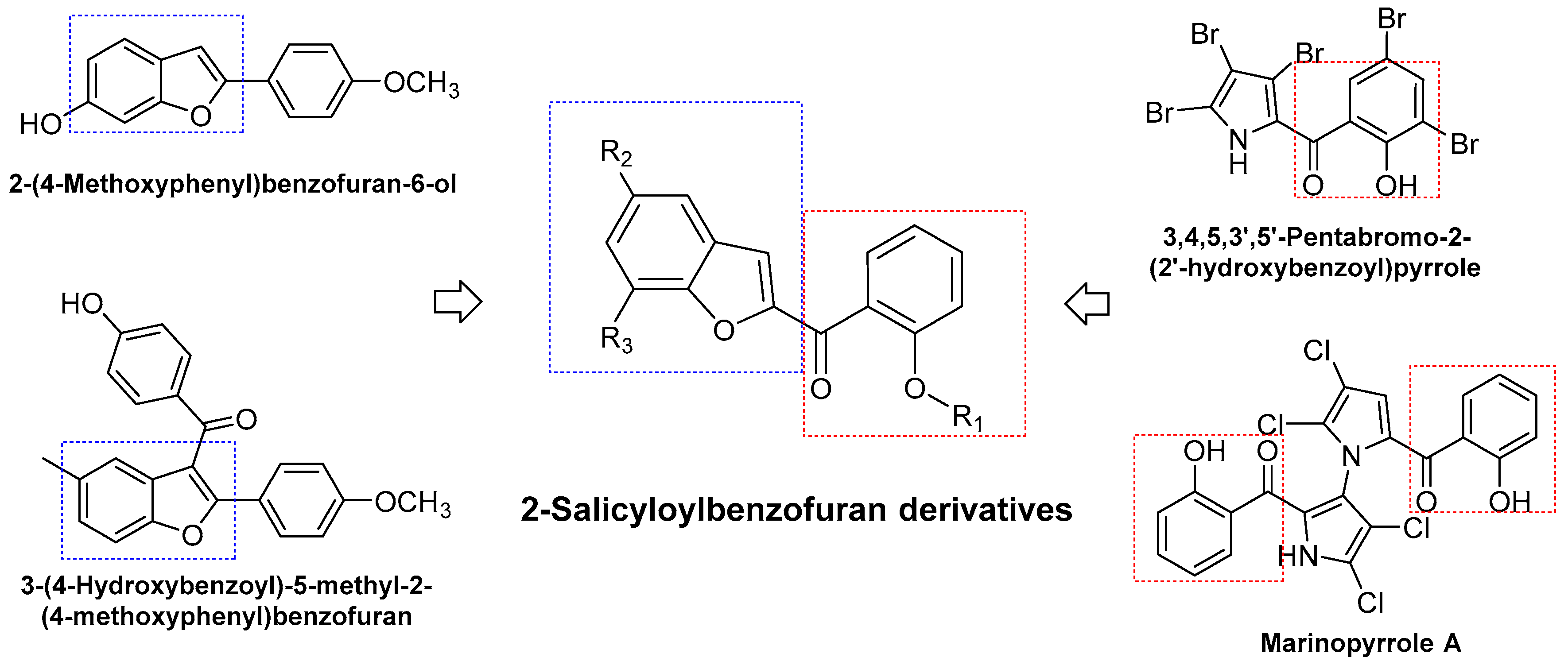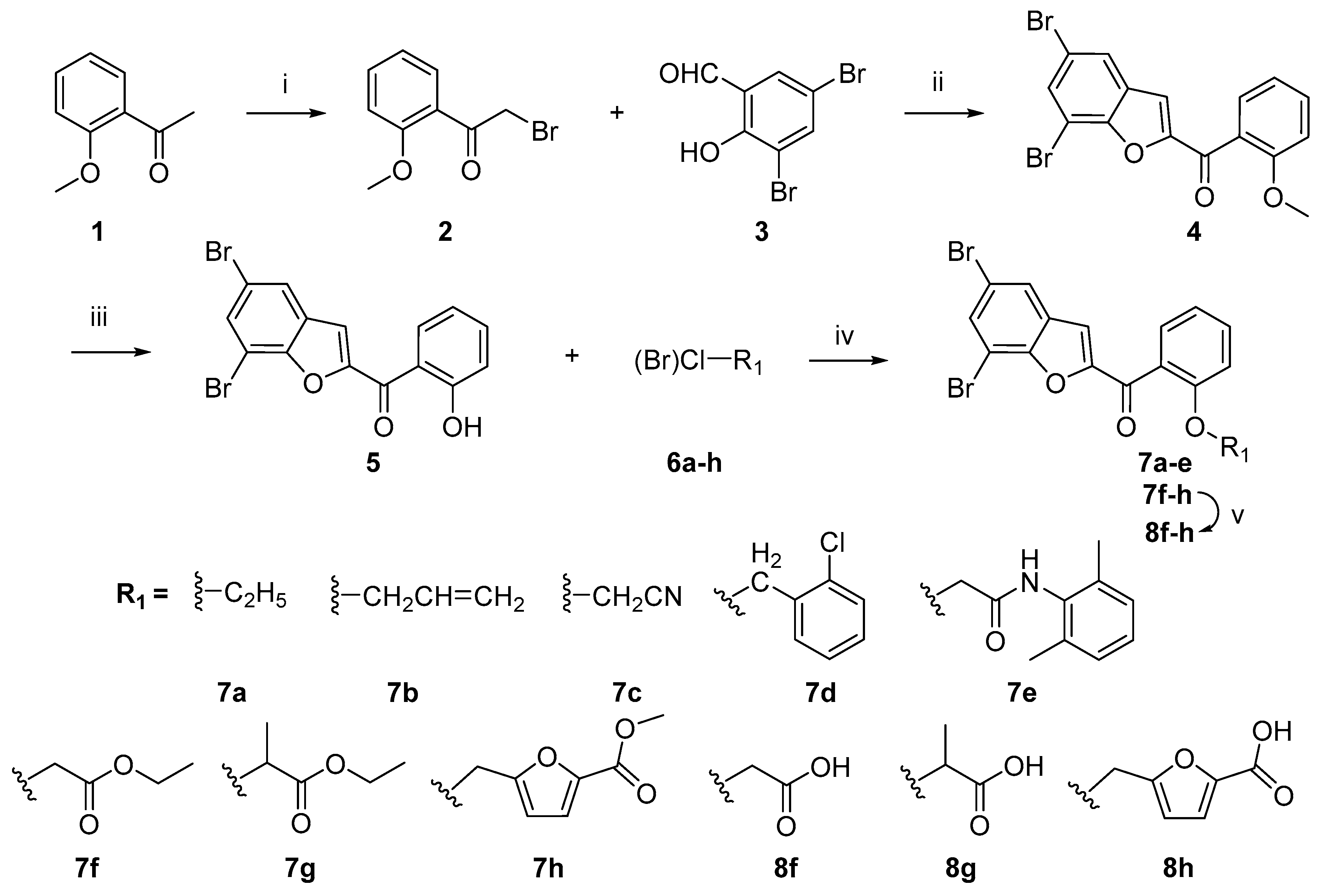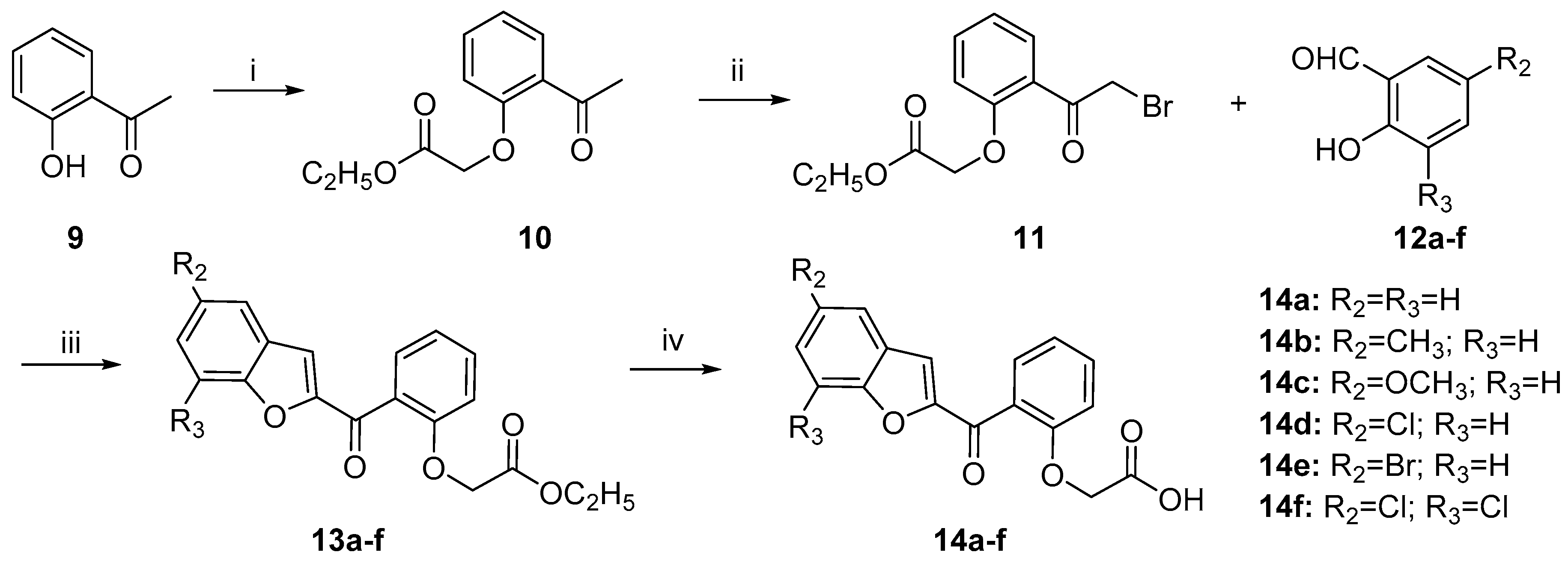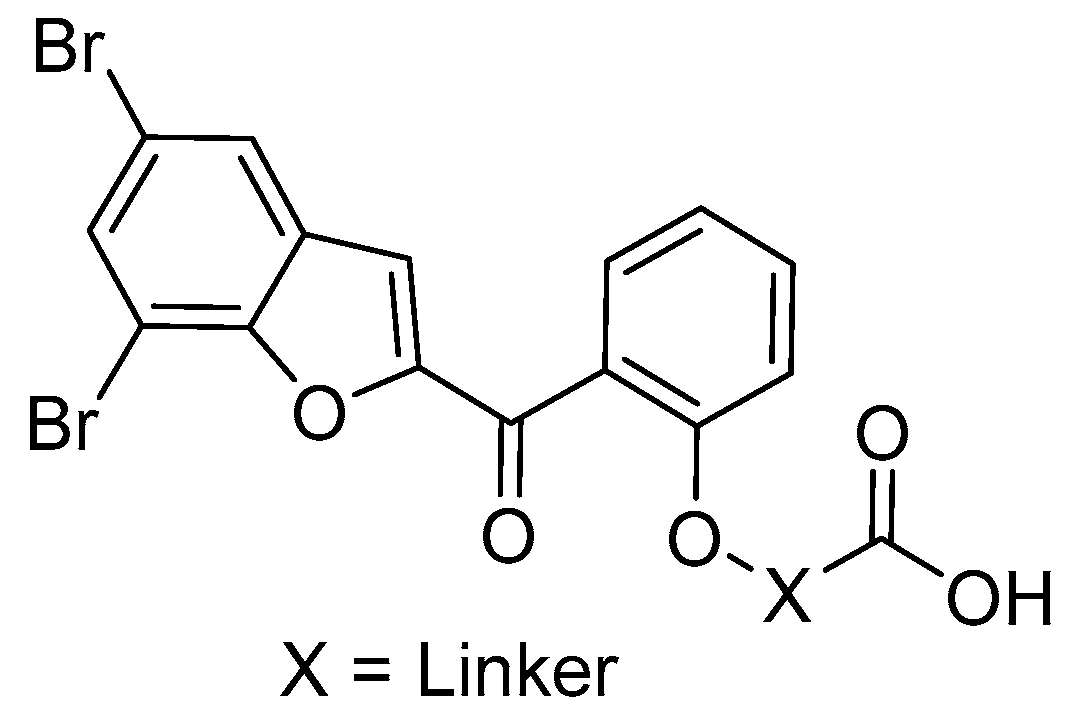3.2. Synthesis
3.2.1. General Procedure for the Synthesis of Phenacyl Bromides 2, 11
The round-bottom flask containing acetophenone derivative 1, 10 (4 mmol) and PTSA (0.076 g, 0.4 mmol) was heated to 60 °C to turn the reaction mixture into a paste and NBS (0.854 g, 4.8 mmol) then added slowly. After 15 min, the reaction mixture was cooled to room temperature and water (20 mL) added. The crude product was extracted with dichloromethane (2 × 20 mL), dried over anhydrous Na2SO4 and purified by crystallization from n-hexane–dichloromethane to give pure product.
2-Methoxyphenacyl bromide (
2): Yellow solid, soluble in acetone, dichloromethane, chloroform, insoluble in water; yield 83%; m.p.: 43–45 °C;
1H-NMR (500 MHz, CDCl
3) (δ, ppm): 7.78 (dd, 1H,
J = 1.5, 7.5 Hz, Ar–H), 7.51–7.47 (m, 1H, Ar–H), 7.02–6.96 (m, 2H, Ar–H), 4.57 (s, 2H, CH
2), 3.93 (s, 3H, OCH
3). This result showed consistency with the data in literature [
26].
Ethyl 2-(2-(2-bromoacetyl)phenoxy)acetate (11): White solid, soluble in dichloromethane, chloroform, insoluble in water; yield 74%; m.p.: 75–76 °C; 1H-NMR (500 MHz, CDCl3) (δ, ppm): 7.85 (dd, 1H, J = 1.5, 7.5 Hz, Ar–H), 7.52–7.49 (m, 1H, Ar–H), 7.11–7.08 (m, 1H, Ar–H), 6.86 (d, 1H, J = 8.0 Hz, Ar–H), 4.79 (s, 2H, CH2), 4.74 (s, 2H, CH2), 4.30 (q, 2H, J = 7.0 Hz, CH2CH3), 1.33 (t, 3H, J = 7.0 Hz, CH2CH3); 13C-NMR (125 MHz, CDCl3) (δ, ppm): 192.4 (C=Oketone), 167.7 (C=Oester), 156.6, 134.5, 131.8, 125.5, 122.1, 112.2, 65.7 (CH2COOCH2CH3), 61.7 (CH2COOCH2CH3), 37.8 (CH2Br), 14.1 (CH3); HRMS (ESI) m/z 301.0028 [M + H]+, calculated for (C12H14BrO4): 301.0075.
3.2.2. General Procedure for the Synthesis of 2-Salicyloylbenzofurans 4, 13a–f
In a round-bottom flask containing DMAP (0.012 g, 0.1 mmol) and Na2CO3 (0.159 g, 1.5 mmol) in water (10 mL), phenacyl bromide 2 or 11 (1 mmol) and salicylaldehyde derivative 3, 12a–f (1 mmol) were added. The resulting mixture was stirred at 80 °C for 5 h. The mixture was extracted with CH2Cl2 (3 × 15 mL), and then washed with water (30 mL). The organic layers were combined, dried over anhydrous Na2SO4 and evaporated under vacuum. The obtained residue was purified by column chromatography on silica gel (n-hexane:dichloromethane = 1:1, v/v) to give pure product.
5,7-Dibromo-2-(2-methoxybenzoyl)benzofuran (4): Yellow solid, soluble in dichloromethane, chloroform, insoluble in water; yield 72%; m.p. 175–176 °C; 1H-NMR (500 MHz, CDCl3) (δ, ppm): 7.76–7.75 (m, 2H, Ar–H), 7.55–7.51 (m, 2H, Ar–H), 7.34 (s, 1H, Ar–H), 7.08 (t, 1H, J = 7.5 Hz, Ar–H), 7.04 (d, 1H, J = 8.5 Hz, Ar–H), 3.81 (s, 3H, OCH3); 13C-NMR (125 MHz, CDCl3) (δ, ppm): 184.3 (C=O), 158.1, 154.7, 152.0, 133.2, 133.1, 130.0, 129.7, 127.4, 124.8, 120.6, 116.8, 114.4, 111.9, 105.9, 55.9 (OCH3); HRMS (ESI) m/z 410.9169 [M + H]+, calculated for (C16H11Br2O3): 410.9054.
Ethyl 2-(2-(benzofuran-2-carbonyl)phenoxy)acetate (13a): Yellow brown oil, soluble in dichloromethane, chloroform, insoluble in water; yield 60%; 1H-NMR (500 MHz, CDCl3) (δ, ppm): 7.68 (d, 1H, J = 8.0 Hz, Ar–H), 7.59 (dd, 1H, J = 1.0, 8.5 Hz, Ar–H), 7.54 (dd, 1H, J = 2.0, 7.5 Hz, Ar–H), 7.50–7.45 (m, 3H, Ar–H), 7.29 (td, 1H, J = 0.5, 7.5 Hz, Ar–H), 7.13 (td, 1H, J = 1.0, 7.5 Hz, Ar–H), 6.90 (d, 1H, J = 8.0 Hz, Ar–H), 4.63 (s, 2H, CH2), 4.15 (q, 2H, J = 7.0 Hz, CH2CH3), 1.19 (t, 3H, J = 7.0 Hz, CH2CH3); 13C-NMR (125 MHz, CDCl3) (δ, ppm): 184.5 (C=Oketone), 168.3 (C=Oester), 156.0, 155.8, 152.9, 132.4, 130.0, 128.6, 128.3, 127.2, 123.7, 123.4, 121.7, 116.8, 112.8, 112.5, 66.0 (CH2COOCH2CH3), 61.3 (CH2COOCH2CH3), 14.0 (CH3); HRMS (ESI) m/z 325.1027 [M + H]+, calculated for (C19H17O5): 325.1076.
Ethyl 2-(2-(5-methylbenzofuran-2-carbonyl)phenoxy)acetate (13b): Yellow brown oil, soluble in dichloromethane, chloroform, insoluble in water; yield 57%; 1H-NMR (500 MHz, CDCl3) (δ, ppm): 7.53 (dd, 1H, J = 1.5, 7.5 Hz, Ar–H), 7.49–7.44 (m, 3H, Ar–H), 7.39 (s, 1H, Ar–H), 7.28 (dd, 1H, J = 1.5, 8.5 Hz, Ar–H), 7.12 (t, 1H, J = 7.5 Hz, Ar–H), 6.90 (d, 1H, J = 8.5 Hz, Ar–H), 4.62 (s, 2H, CH2), 4.15 (q, 2H, J = 7.0 Hz, CH2CH3), 2.44 (s, 3H, CH3), 1.20 (t, 3H, J = 7.0 Hz, CH2CH3); 13C-NMR (125 MHz, CDCl3) (δ, ppm): 182.4 (C=Oketone), 171.1 (C=Oester), 154.7, 153.8, 152.0, 135.5, 133.5, 132.9, 129.7, 129.6, 125.0, 117.0, 115.6, 114.7, 113.9, 105.9, 73.5 (CH2COOCH2CH3), 61.6 (CH2COOCH2CH3), 18.2 (CH3), 14.1 (CH2CH3); HRMS (ESI) m/z 339.1222 [M + H]+, calculated for (C20H19O5): 339.1232.
Ethyl 2-(2-(5-methoxybenzofuran-2-carbonyl)phenoxy)acetate (13c): Yellow brown oil, soluble in dichloromethane, chloroform, insoluble in water; yield 66%; 1H-NMR (500 MHz, CDCl3) (δ, ppm): 7.53 (dd, 1H, J = 1.5, 7.5 Hz, Ar–H), 7.50–7.46 (m, 2H, Ar–H), 7.41 (s, 1H, Ar–H), 7.13 (d, 1H, J = 7.0 Hz, Ar–H), 7.11–7.06 (m, 2H, Ar–H), 6.90 (d, 1H, J = 8.5 Hz, Ar–H), 4.63 (s, 2H, CH2), 4.16 (q, 2H, J = 7.0 Hz, CH2CH3), 3.84 (s, 3H, OCH3), 1.20 (t, 3H, J = 7.0 Hz, CH2CH3); 13C-NMR (125 MHz, CDCl3) (δ, ppm): 183.7 (C=Oketone), 168.4 (C=Oester), 161.2, 157.7, 155.7, 152.5, 132.1, 129.9, 128.9, 123.7, 121.6, 120.6, 117.7, 114.3, 112.8, 95.6, 66.0 (CH2COOCH2CH3), 61.3 (CH2COOCH2CH3), 55.7 (OCH3), 14.0 (CH2CH3); HRMS (ESI) m/z 355.1165 [M + H]+, calculated for (C20H19O6): 355.1182.
Ethyl 2-(2-(5-chlorobenzofuran-2-carbonyl)phenoxy)acetate (13d): Yellow brown oil, soluble in dichloromethane, chloroform, insoluble in water; yield 70%; 1H-NMR (500 MHz, CDCl3) (δ, ppm): 7.65 (d, 1H, J = 7.0 Hz, Ar–H), 7.54–7.48 (m, 3H, Ar–H), 7.43 (d, 1H, J = 0.5 Hz, Ar–H), 7.41 (dd, 1H, J = 2.0, 8.5 Hz, Ar–H), 7.14–7.11 (m, 1H, Ar–H), 6.89 (d, 1H, J = 8.5 Hz, Ar–H), 4.62 (s, 2H, CH2), 4.16 (q, 2H, J = 7.0 Hz, CH2CH3), 1.21 (t, 3H, J = 7.0 Hz, CH2CH3); 13C-NMR (125 MHz, CDCl3) (δ, ppm): 184.4 (C=Oketone), 168.2 (C=Oester), 155.8, 154.2, 154.0, 132.8, 132.7, 130.1, 129.3, 128.5, 128.3, 122.7, 121.8, 115.6, 113.6, 112.7, 65.8 (CH2COOCH2CH3), 61.4 (CH2COOCH2CH3), 14.0 (CH3); HRMS (ESI) m/z 359.0672 [M + H]+, calculated for (C19H16BrO5): 359.0686.
Ethyl 2-(2-(5-bromobenzofuran-2-carbonyl)phenoxy)acetate (13e): Yellow brown oil, soluble in dichloromethane, chloroform, insoluble in water; yield 72%; 1H-NMR (500 MHz, CDCl3) (δ, ppm): 7.82 (d, 1H, J = 1.5 Hz, Ar–H), 7.56–7.46 (m, 4H, Ar–H), 7.43 (s, 1H, Ar–H), 7.13 (t, 1H, J = 7.5 Hz, Ar–H), 6.89 (d, 1H, J = 8.0 Hz, Ar–H), 4.62 (s, 2H, CH2), 4.16 (q, 2H, J = 7.0 Hz, CH2CH3), 1.21 (t, 3H, J = 7.0 Hz, CH2CH3); 13C-NMR (125 MHz, CDCl3) (δ, ppm): 183.9 (C=Oketone), 168.1 (C=Oester), 156.1, 154.4, 151.9, 133.1, 133.0, 130.3, 129.7, 128.0, 124.9, 121.9, 116.7, 115.0, 112.8, 105.8, 66.0 (CH2COOCH2CH3), 61.4 (CH2COOCH2CH3), 14.0 (CH3); HRMS (ESI) m/z 403.0168 [M + H]+, calculated for (C19H16BrO5): 403.0181.
Ethyl 2-(2-(5,7-dichlorobenzofuran-2-carbonyl)phenoxy)acetate (13f): Yellow brown oil, soluble in dichloromethane, chloroform, insoluble in water; yield 68%; 1H-NMR (500 MHz, CDCl3) (δ, ppm): 7.57 (d, 1H, J = 2.0 Hz, Ar–H), 7.56 (dd, 1H, J = 2.0, 7.5 Hz, Ar–H), 7.53–7.50 (m, 1H, Ar–H), 7.49 (s, 1H, Ar–H), 7.46 (d, 1H, J = 2.0 Hz, Ar–H), 7.14 (td, 1H, J = 1.0, 7.5 Hz, Ar–H), 6.91 (d, 1H, J = 8.5 Hz, Ar–H), 4.64 (s, 2H, CH2), 4.13 (q, 2H, J = 7.0 Hz, CH2CH3), 1.19 (t, 3H, J = 7.0 Hz, CH2CH3); 13C-NMR (125 MHz, CDCl3) (δ, ppm): 184.01 (C=Oketone), 168.2 (C=Oester), 156.2, 154.7, 150.3, 133.1, 130.4, 129.6, 129.5, 128.1, 127.9, 122.0, 121.3, 118.5, 115.1, 112.9, 66.0 (CH2COOCH2CH3), 61.4 (CH2COOCH2CH3), 14.0 (CH3); HRMS (ESI) m/z 393.0246 [M + H]+, calculated for (C19H15Cl2O5): 393.0297.
3.2.3. Synthesis of 5,7-Dibromo-2-salicyloylbenzofuran 5
Anhydrous AlCl3 (0.267 g, 2.0 mmol) was added to a solution of substrate 4 (0.410 g, 1.0 mmol) in CH2Cl2 (10 mL) in one portion at 0 °C. The reaction mixture was stirred at the same temperature for 5 min. then warmed up to room temperature and stirred for a further 3 h. The reaction mixture was poured into cold water (20 mL) and extracted with CH2Cl2 (2 × 20 mL). The combined organic layer was washed successively with saturated NaHCO3 and brine, and then dried over anhydrous Na2SO4. The solvent was evaporated under vacuum and the crude product was purified by column chromatography (n-hexan:dichloromethane = 1:1, v/v) to obtain product as yellow solid. Yield 89%, soluble in dichloromethane, chloroform, insoluble in water; m.p. 132–134 °C; 1H-NMR (500 MHz, CDCl3) (δ, ppm): 12.04 (s, 1H, OH), 8.47 (dd, 1H, J = 1.5, 6.5 Hz, Ar–H), 7.82 (d, 1H, J = 1.5 Hz, Ar–H), 7.79 (d, 1H, J = 2.0 Hz, Ar–H), 7.67 (s, 1H, Ar–H), 7.59–7.55 (m, 1H, Ar–H), 7.08 (dd, 1H, J = 1.0, 7.5 Hz, Ar–H), 7.05–7.02 (m, 1H, Ar–H); 13C-NMR (125 MHz, CDCl3) (δ, ppm): 185.9 (C=O), 164.1, 154.0, 152.3, 137.3, 133.5, 131.9, 129.2, 124.9, 119.6, 118.8, 118.9, 117.5, 115.6, 106.0; HRMS (ESI) m/z 394.8756 [M − H]−, calculated for (C15H7Br2O3): 394.8741.
3.2.4. General Procedure for the Synthesis of O-ether Derivatives 7a–h, 10
A mixture of 5 or 9 (1 mmol), halogenated material 6a–h (1.2 mmol) (6a: ethyl bromide, 6b: allyl bromide; 6c: 2-bromoacetonitrile, 6d: 2-chlorobenzyl chloride, 6e: 2-chloro-N-(2,6-dimethylphenyl)acetamide, 6f: ethyl chloroacetate, 6g: ethyl 2-bromopropanoate, 6h: methyl 5-(chloromethyl)furan-2-carboxylate) and anhydrous K2CO3 (0.276 g, 2.0 mmol) in dry acetone (10 mL) was refluxed for 8 h. The reaction mixture was cooled to room temperature and the solvent was removed under reduced pressure. The residue was triturated with ice water to remove K2CO3 and then extracted with dichloromethane (3 × 15 mL). The organic layer was dried over anhydrous Na2SO4, evaporated under vacuum to dryness. The obtained residue was purified by column chromatography using n-hexane and dichloromethane (1:1) as eluent to give pure product.
5,7-Dibromo-2-(2-ethoxybenzoyl)benzofuran (7a): Yellow solid, soluble in dichloromethane, chloroform, insoluble in water; yield 75%; m.p. 78–80 °C; 1H-NMR (500 MHz, CDCl3) (δ, ppm): 7.77 (d, 1H, J = 1.5 Hz, Ar–H), 7.75 (s, 1H, Ar–H), 7.53–7.50 (m, 2H, Ar–H), 7.37 (s, 1H, Ar–H), 7.08–7.05 (m, 1H, Ar–H), 7.01 (d, 1H, J = 8.5 Hz, Ar–H), 4.07 (q, 1H, J = 7.0 Hz, CH2), 1.12 (t, 3H, J = 7.0 Hz, CH3); 13C-NMR (125 MHz, CDCl3) (δ, ppm): 184.7 (C=O), 157.6, 154.9, 151.8, 133.3, 133.0, 130.1, 129.7, 127.5, 124.8, 120.6, 116.8, 113.6, 112.7, 105.8, 64.3 (CH2), 14.5 (CH3); HRMS (ESI) m/z 422.9249 [M + H]+, calculated for (C17H13Br2O3): 422.9231.
2-(2-Allyloxybenzoyl)-5,7-dibromobenzofuran (7b): Yellow solid, soluble in dichloromethane, chloroform, insoluble in water; yield 79%; m.p. 78–80 °C; 1H-NMR (500 MHz, CDCl3) (δ, ppm): 7.76 (d, 1H, J = 1.5 Hz, Ar–H), 7.74 (d, 1H, J = 2.0 Hz, Ar–H), 7.54–7.50 (m, 2H, Ar–H), 7.39 (s, 1H, Ar–H), 7.10–7.07 (m, 1H, Ar–H), 7.03 (d, 1H, J = 8.5 Hz, Ar–H), 5.80–5.75 (m, 1H, CH2CH=CH2), 5.15 (dd, 1H, J = 1.5, 16.0 Hz, CH2CH=CH2), 5.05 (dd, 1H, J = 1.5, 10.0 Hz, CH2CH=CH2), 4.56 (dd, 2H, J = 1.5, 3.5 Hz, CH2CH=CH2); 13C-NMR (125 MHz, CDCl3) (δ, ppm): 184.5 (C=O), 157.2, 154.8, 151.9, 133.3, 133.1, 132.4, 130.1, 129.7, 127.7, 124.8, 120.9, 117.4, 116.8, 113.8, 113.1, 105.9, 69.5 (CH2CH=CH2); HRMS (ESI) m/z 476.8714 [M + K]+, calculated for (C18H12Br2KO3): 476.8749.
2-(2-(5,7-Dibromobenzofuran-2-carbonyl)phenoxy)acetonitrile (7c): White solid, soluble in dichloromethane, acetone, insoluble in water; yield 87%; m.p.: 178–179 °C; 1H-NMR (500 MHz, CDCl3) (δ, ppm): 7.78 (d, 1H, J = 1.5 Hz, Ar–H), 7.77 (d, 1H, J = 1.5 Hz, Ar–H), 7.62–7.59 (m, 2H, Ar–H), 7.34 (s, 1H, Ar–H), 7.26 (t, 1H, J = 8.0 Hz, Ar–H), 7.19 (d, 1H, J = 8.5 Hz, Ar–H), 4.81 (s, 2H, CH2); 13C-NMR (125 MHz, CDCl3) (δ, ppm): 183.1 (C=O), 154.9, 154.0, 152.1, 133.6, 133.4, 130.5, 129.5, 128.6, 125.0, 123.5, 117.2, 115.2, 114.6, 114.1, 105.9, 54.8 (CH2); HRMS (ESI) m/z 433.8770 [M − H]−, calculated for (C17H8Br2NO3): 433.8851.
2-(2-(2-Chlorobenzyloxy)benzoyl)-5,7-dibromobenzofuran (7d): Yellow solid, soluble in dichloromethane, chloroform, insoluble in water; yield 77%; m.p.: 125–127 °C; 1H-NMR (500 MHz, CDCl3) (δ, ppm): 7.71 (s, 1H, Ar–H), 7.67 (s, 1H, Ar–H), 7.59–7.53 (m, 2H, Ar–H), 7.39 (s, 1H, Ar–H), 7.27 (d, 1H, J = 8.5 Hz, Ar–H), 7.14–7.11 (m, 4H, Ar–H), 6.99 (m, 1H, Ar–H), 5.20 (s, 2H, CH2); 13C-NMR (125 MHz, CDCl3) (δ, ppm): 184.5 (C=O), 157.1, 154.7, 151.9, 133.9, 133.47, 133.0, 131.9, 130.3, 129.6, 129.1, 128.8, 127.8, 127.6, 126.8, 124.7, 121.3, 116.8, 113.9, 113.3, 105.9, 67.9 (CH2 ); HRMS (ESI) m/z 542.8563 [M + Na]+, calculated for (C22H13Br2ClNaO3): 542.8797.
2-(2-(5,7-Dibromobenzofuran-2-carbonyl)phenoxy)-N-(2,6-dimethylphenyl)acetamide (7e): Yellow solid, soluble in dichloromethane, chloroform, insoluble in water; yield 75%; m.p.: 177–179 °C; 1H-NMR (500 MHz, CDCl3) (δ, ppm): 8.65 (s, 1H, NH), 7.76–7.72 (m, 3H, Ar–H), 7.65–7.62 (m, 1H, Ar–H), 7.44 (s, 1H, Ar–H), 7.20 (t, 1H, J = 7.5 Hz, Ar–H), 7.16 (d, 1H, J = 8.5 Hz, Ar–H), 7.12–7.05 (m, 3H, Ar–H), 4.81 (s, 2H, CH2), 2.12 (s, 6H, CH3); 13C-NMR (125 MHz, CDCl3) (δ, ppm): 183.2 (C=Oketone), 166.2 (C=Oamide), 156.3, 153.8, 152.3, 135.3, 134.2, 133.8, 133.0, 133.0, 131.0, 129.3, 129.3, 128.2, 127.4, 126.4, 124.9, 121.7, 117.3, 115.8, 113.4, 106.1, 67.8 (CH2), 18.3 (CH3); HRMS (ESI) m/z 579.9592 [M + Na]+, calculated for (C25H19Br2NNaO4): 579.9558.
Ethyl 2-(2-(5,7-dibromobenzofuran-2-carbonyl)phenoxy)acetate (7f): White solid, soluble in dichloromethane, acetone, insoluble in water; yield 64%; m.p.: 77–78 °C; 1H-NMR (500 MHz, CDCl3) (δ, ppm): 7.77 (d, 1H, J = 1.5 Hz, Ar–H), 7.74 (d, 1H, J = 1.5 Hz, Ar–H), 7.57–7.50 (m, 3H, Ar–H), 7.16–7.13 (m, 1H, Ar–H), 6.91 (d, 1H, J = 8.0 Hz, Ar–H), 4.64 (s, 2H, CH2COOCH2CH3), 4.12 (q, 2H, J = 7.0 Hz, CH2COOCH2CH3), 1.19 (t, 3H, J = 7.0 Hz, CH3); 13C-NMR (125 MHz, CDCl3) (δ, ppm): 184.0 (C=Oketone), 168.2 (C=Oester), 156.2, 154.4, 152.0, 133.1, 133.1, 130.4, 129.8, 128.1, 124.9, 122.0, 116.8, 115.0, 112.8, 105.9, 66.1 (CH2COOCH2CH3), 61.4 (CH2COOCH2CH3), 14.0 (CH3); HRMS (ESI) m/z 504.9030 [M + Na]+, calculated for (C19H14Br2NaO5): 504.9085.
Ethyl 2-(2-(5,7-dibromobenzofuran-2-carbonyl)phenoxy)propanoate (7g): Brown oil, soluble in dichloromethane, chloroform, insoluble in water; yield 60%; 1H-NMR (500 MHz, CDCl3) (δ, ppm): 7.77–7.75 (m, 2H, Ar–H), 7.57 (s, 1H, Ar–H), 7.53 (d, 1H, J = 7.5 Hz, Ar–H), 7.47 (t, 1H, J = 8.0 Hz, Ar–H), 7.10 (t, 1H, J = 7.5 Hz, Ar–H), 6.83 (d, 1H, J = 8.5 Hz, Ar–H), 4.76 (q, 1H, J = 6.5 Hz, CH), 4.18 (q, 2H, J = 7.0 Hz, CH2), 1.37 (d, 3H, J = 6.5 Hz, CH3CH), 1.24 (t, 3H, J = 7.0 Hz, CH2CH3); 13C-NMR (125 MHz, CDCl3) (δ, ppm): 184.1 (C=Oketone), 171.6 (C=Oester), 155.7, 154.4, 151.9, 133.2, 133.0, 130.4, 129.8, 128.1, 124.9, 121.6, 116.8, 115.3, 112.8, 105.9, 73.2 (CH3CH), 61.4 (CH2CH3) , 18.3 (CH3CH), 14.1 (CH2CH3); HRMS (ESI) m/z 518.9387 [M + Na]+, calculated for (C20H16Br2NaO5): 518.9242.
Methyl 5-((2-(5,7-dibromobenzofuran-2-carbonyl)phenoxy)methyl)furan-2-carboxylate (7h): White solid, soluble in dichloromethane, acetone, insoluble in water; yield 77%; m.p.: 122–124 °C; 1H-NMR (500 MHz, CDCl3) (δ, ppm): 7.75 (d, 1H, J = 1.5 Hz, Ar–H), 7.72 (d, 1H, J = 1.5 Hz, Ar–H), 7.56–7.52 (m, 2H, Ar–H), 7.36 (s, 1H, Ar–H), 7.14 (t, 1H, J = 7.5 Hz, Ar–H), 7.10 (d, 1H, J = 8.5 Hz, Ar–H), 6.97 (d, 1H, J = 3.5 Hz, Ar–H), 6.24 (d, 1H, J = 3.5 Hz, Ar–H), 5.10 (s, 2H, CH2), 3.87 (s, 3H, CH3); 13C-NMR (125 MHz, CDCl3) (δ, ppm): 182.5 (C=Oketone), 158.7 (C=Oester), 155.4, 154.0, 153.0, 151.9, 144.6, 135.8, 133.4, 132.8, 129.7, 129.5, 125.0, 118.5, 117.0, 115.1, 114.6, 114.2, 111.4, 105.9, 63.6 (CH2), 52.1 (CH3); HRMS (ESI) m/z 556.9210 [M + Na]+, calculated for (C22H14Br2NaO6): 556.9034.
Ethyl 2-(2-acetylphenoxy)acetate (10): White solid, soluble in dichloromethane, chloroform, insoluble in water; yield 77%; m.p.: 46–48 °C; 1H-NMR (500 MHz, CDCl3) (δ, ppm): 7.76 (dd, 1H, J = 1.5, 7.5 Hz, Ar–H), 7.46–7.42 (m, 1H, Ar–H), 7.05 (t, 1H, J = 7.5 Hz, Ar–H), 6.83 (d, 1H, J = 8.5 Hz, Ar–H), 6.83 (d, 1H, J = 8.5 Hz, Ar–H), 4.72 (s, 2H, CH2) 4.28 (q, 2H, J = 7.0 Hz, CH2CH3), 2.72 (s, 3H, CH3C=O), 1.30 (t, 3H, J = 7.0 Hz, CH2CH3); 13C-NMR (125 MHz, CDCl3) (δ, ppm): 199.6 (C=Oketone), 168.1 (C=Oester), 157.0, 133.5, 130.6, 128.9, 121.6, 112.2, 65.5 (CH2COOCH2CH3), 61.5 (CH2COOCH2CH3), 32.0 (CH3CO), 14.1 (CH2CH3); HRMS (ESI) m/z 223.0963 [M + H]+, calculated for (C12H15O4): 223.0970.
3.2.5. General Procedure for the Synthesis of Carboxylic Acid Derivatives of 2-salicyloylbenzofurans 8f–h and 14a–f
To a solution of the ester 7f–h, 13a–f (1 mmol) in a solvent mixture of dichloromethane and methanol (9:1, v/v, 15 mL) was added a methanolic solution of NaOH 2N (1 mL). After 5–10 min of stirring, the sodium salt of the carboxylic acid started to precipitate (except compound 13a–c, the solid not formed). The mixture was stirred and monitored by TLC (n-hexane–dichloromethane = 1:1) until all the ester was consumed (after 30–60 min).
Purification for product 8f–h, 14d–f: The reaction mixture was filtered under reduced pressure, washed with dichloromethane (10 mL) to obtain white solid that was then dissolved in dimethylformamide (DMF) (15–20 mL). The mixture was cooled, acidified to pH 3–4 with dilute HCl to afford the respective carboxylic acid. The mixture was then filtered, washed with cold water and dried in vacuum-heating oven to obtain the targeted product.
Purification for product 14a–c: The reaction mixture was added water (40 mL) and then extracted with dichloromethane (10 mL × 2) to remove impurities. The water solution was cooled, acidified to pH 3–4 with dilute HCl to afford the respective carboxylic acid that extracted with ethyl acetate (15 mL × 2). The combined organic layer was dried over anhydrous Na2SO4, and then evaporated under vacuum to dryness. The obtained residue was dried in vacuum-heating oven to obtain the targeted product.
2-(2-(5,7-Dibromobenzofuran-2-carbonyl)phenoxy)acetic acid (8f): White solid, soluble in dimethyl sulfoxide, ethyl acetate, insoluble in water; yield 70%; m.p. 156–158 °C; 1H-NMR (500 MHz, DMSO-d6) (δ, ppm): 8.03 (s, 1H, Ar–H), 8.01 (s, 1H, Ar–H), 7.65 (s, 1H, Ar–H), 7.60–7.57 (m, 1H, Ar–H), 7.53 (d, 1H, J = 7.5 Hz, Ar–H), 7.15–7.14 (m, 2H, Ar–H), 4.72 (s, 2H, CH2); 13C-NMR (125 MHz, DMSO-d6) (δ, ppm): 183.65 (C=Oketone), 169.5 (C=Oacid), 155.7, 153.5, 151.4, 133.0, 132.7, 129.8, 129.5, 127.1, 125.7, 121.2, 116.3, 116.3, 113.2, 105.2, 65.1 (CH2); HRMS (ESI) m/z 476.8714 [M + Na]+, calculated for (C17H10Br2NaO5): 476.8772.
2-(2-(5,7-Dibromobenzofuran-2-carbonyl)phenoxy)propanoic acid (8g): Yellow solid, soluble in dimethyl sulfoxide, ethyl acetate, insoluble in water; yield 75%; m.p.: 153–155 °C; 1H-NMR (500 MHz, DMSO-d6) (δ, ppm): 8.03 (d, 1H, J = 1.5 Hz, Ar–H), 7.99 (d, 1H, J = 1.5 Hz, Ar–H), 7.69 (s, 1H, Ar–H), 7.59–7.55 (m, 1H, Ar–H), 7.53–7.51 (m, 1H, Ar–H), 7.13 (t, 1H, J = 7.5 Hz, Ar–H), 7.04 (d, 1H, J = 8.0 Hz, Ar–H), 4.90 (q, 1H, J = 6.5 Hz, CH), 1.24 (d, 3H, J = 6.5 Hz, CH3); 13C-NMR (125 MHz, DMSO-d6) (δ, ppm): 183.7 (C=Oketone), 172.5 (C=Oacid), 155.4, 153.6, 151.3, 133.1, 132.7, 129.7, 127.2, 125.7, 121.0, 116.3, 116.0, 113.2, 105.2, 72.1 (CH3CH), 17.8 (CH3); HR-MS (ESI) m/z 466.8869 [M − H]−, calculated for (C18H11Br2O5): 466.8953.
5-((2-(5,7-Dibromobenzofuran-2-carbonyl)phenoxy)methyl)furan-2-carboxylic acid (8h): White solid, soluble in dimethyl sulfoxide, ethyl acetate, insoluble in water; yield 82%; m.p.: 131–133 °C; 1H-NMR (500 MHz, DMSO-d6) (δ, ppm): 8.01 (d, 1H, J = 1.5 Hz, Ar–H), 7.97 (d, 1H, J = 1.5 Hz, Ar–H), 7.54–7.60 (m, 1H, Ar–H), 7.55 (s, 1H, Ar–H), 7.53 (dd, 1H, J = 1.5, 7.5 Hz, Ar–H), 7.40 (d, 1H, J = 8.5 Hz, Ar–H), 7.16 (t, 1H, J = 7.5 Hz, Ar–H), 7.03 (d, 1H, J = 3.5 Hz, Ar–H), 6.49 (d, 1H, J = 3.5 Hz, Ar–H), 5.21 (s, 2H, CH2); 13C-NMR (125 MHz, DMSO-d6) (δ, ppm): 183.6 (C=Oketone), 159.0 (C=Oacid), 155.7, 153.5, 153.3, 151.3, 145.0, 133.2, 132.8, 129.7, 129.6, 127.4, 125.8, 121.4, 118.1, 116.4, 116.1, 113.8, 112.0, 105.2, 62.4 (CH2); HRMS (ESI) m/z 518.8745 [M − H]−, calculated for (C21H11Br2O6): 518.8902.
2-(2-(Benzofuran-2-carbonyl)phenoxy)acetic acid (14a): Yellow solid, soluble in dimethyl sulfoxide, ethyl acetate, insoluble in water; yield 72%; m.p.: 115–117 °C; 1H-NMR (500 MHz, CDCl3) (δ, ppm): 7.75 (d, 1H, J = 7.5 Hz, Ar–H), 7.72 (d, 1H, J = 8.0 Hz, Ar–H), 7.63–7.58 (m, 2H, Ar–H), 7.54–7.51 (m, 2H, Ar–H), 7.34 (t, 1H, J = 7.0 Hz, Ar–H), 7.20 (t, 1H, J = 7.5 Hz, Ar–H), 7.08 (d, 1H, J = 8.5 Hz, Ar–H), 4.79 (s, 2H, CH2); 13C-NMR (125 MHz, CDCl3) (δ, ppm): 184.5 (C=Oketone), 170.3 (C=Oacid), 156.6, 156.4, 152.0, 134.0, 131.2, 129.2, 126.9, 124.2, 123.6, 122.3, 118.6, 114.8, 112.6, 67.1 (CH2); HRMS (ESI) m/z 297.0749 [M + H]+, calculated for (C17H13O5): 297.0763.
2-(2-(5-Methylbenzofuran-2-carbonyl)phenoxy)acetic acid (14b): Yellow solid, soluble in dimethyl sulfoxide, ethyl acetate, chloroform, insoluble in water; yield 66%; m.p.: 122–124 °C; 1H-NMR (500 MHz, CDCl3) (δ, ppm): 7.74 (dd, 1H, J = 1.5, 7.5 Hz, Ar–H), 7.61–7.57 (m, 1H, Ar–H), 7.51–7.46 (m, 3H, Ar–H), 7.34 (dd, 1H, J = 1.5, 7.5 Hz, Ar–H), 7.20 (t, 1H, J = 7.5 Hz, Ar–H), 7.08 (d, 1H, J = 8.0 Hz, Ar–H), 4.79 (s, 2H, CH2), 2.46 (s, 3H, CH3); 13C-NMR (125 MHz, CDCl3) (δ, ppm): 184.5 (C=Oketone), 170.3 (C=Oacid), 156.6, 155.1, 152.1, 134.0, 133.9, 131.3, 130.9, 127.1, 126.9, 123.0, 122.3, 118.5, 114.9, 112.2, 67.2 (CH2), 21.3 (CH3); HRMS (ESI) m/z 311.0909 [M + H]+, calculated for (C18H15O5): 311.0919.
2-(2-(5-Methoxybenzofuran-2-carbonyl)phenoxy)acetic acid (14c): Yellow solid, soluble in dimethyl sulfoxide, ethyl acetate, chloroform, insoluble in water; yield 73%; m.p.: 168–171 °C; ; 1H-NMR (500 MHz, CDCl3) (δ, ppm): 7.68 (dd, 1H, J = 1.0, 7.5 Hz, Ar–H), 7.57–7.54 (m, 2H, Ar–H), 7.44 (s, 1H, Ar–H), 7.17 (t, 1H, J = 7.5 Hz, Ar–H), 7.07–7.06 (m, 2H, Ar–H), 6.95 (dd, 1H, J = 2.0, 8.5 Hz, Ar–H), 4.77 (s, 2H, CH2), 3.97 (s, 3H, OCH3); 13C-NMR (125 MHz, CDCl3) (δ, ppm): 183.8 (C=Oketone), 170.6 (C=Oacid), 161.9, 158.3, 156.5, 151.6, 133.7, 131.0, 127.2, 124.0, 122.2, 120.4, 119.7, 115.0, 114.8, 95.5, 67.2 (CH2), 55.8 (OCH3); HRMS (ESI) m/z 327.0853 [M + H]+, calculated for (C18H15O6): 327.0869.
2-(2-(5-Chlorobenzofuran-2-carbonyl)phenoxy)acetic acid (14d): White solid, soluble in dimethyl sulfoxide, ethyl acetate, insoluble in water; yield 79%; m.p.: 175–177 °C; 1H-NMR (500 MHz, DMSO-d6) (δ, ppm): 7.86 (s, 1H, Ar–H), 7.76 (d, 1H, J = 9.0 Hz, Ar–H), 7.56–7.49 (m, 4H, Ar–H), 7.14–7.11 (m, 2H, Ar–H), 4.71 (s, 2H, CH2); 13C-NMR (125 MHz, DMSO-d6) (δ, ppm): 184.0 (C=Oketone), 169.6 (C=Oacid), 155.6, 153.7, 153.5, 132.6, 129.3, 128.5, 128.4, 128.3, 127.5, 123.0, 121.0, 115.9, 114.0, 113.0, 64.9 (CH2); HRMS (ESI) m/z 331.0356 [M + H]+, calculated for (C17H12ClO5): 331.0373.
2-(2-(5-Bromobenzofuran-2-carbonyl)phenoxy)acetic acid (14e): White solid, soluble in dimethyl sulfoxide, ethyl acetate, insoluble in water; yield 81%; m.p.: 145–147 °C; 1H-NMR (500 MHz, DMSO-d6) (δ, ppm): 8.00 (d, 1H, J = 2.0 Hz, Ar–H), 7.71 (d, 1H, J = 8.5 Hz, Ar–H), 7.70 (dd, 1H, J = 2.0, 8.5 Hz, Ar–H), 7.58–7.54 (m, 2H, Ar–H), 7.49 (dd, 1H, J = 1.5, 7.5 Hz, Ar–H), 7.14–7.11 (m, 2H, Ar–H), 4.70 (s, 2H, CH2); 13C-NMR (125 MHz, DMSO-d6) (δ, ppm): 183.9 (C=Oketone), 169.6 (C=Oacid), 155.6, 154.0, 153.2, 132.6, 131.1, 129.3, 129.1, 127.5, 126.0, 121.0, 116.1, 115.7, 114.4, 113.0, 64.9 (CH2); HRMS (ESI) m/z 374.9850 [M + H]+, calculated for (C17H12BrO5): 374.9868.
2-(2-(5,7-Dichlorobenzofuran-2-carbonyl)phenoxy)acetic acid (14f): White solid, soluble in dimethyl sulfoxide, ethyl acetate, insoluble in water; yield 80%; m.p.: 162–164 °C; 1H-NMR (500 MHz, DMSO-d6) (δ, ppm): 7.85 (d, 1H, J = 2.0 Hz, Ar–H), 7.80 (d, 1H, J = 1.5 Hz, Ar–H), 7.64 (s, 1H, Ar–H), 7.58 (td, 1H, J = 1.5, 8.5 Hz, Ar–H), 7.52 (dd, 1H, J = 1.5, 7.5 Hz, Ar–H), 7.16–7.13 (m, 2H, Ar–H), 4.71 (s, 2H, CH2); 13C-NMR (125 MHz, DMSO-d6) (δ, ppm): 183.6 (C=Oketone), 169.5 (C=Oacid), 155.7, 153.9, 149.6, 133.0, 129.5, 129.4, 128.5, 127.6, 127.1, 122.2, 121.1, 117.2, 116.2, 113.2, 65.1 (CH2); HRMS (ESI) m/z 364.9960 [M + H]+, calculated for (C17H11Cl2O5): 364.9984.










